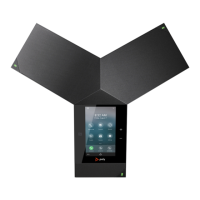Setting Description
Autonegotiation
(under General Settings in the local interface)
Specifies whether the system should automatically
negotiate the LAN speed and duplex mode per IEEE
802.3 autonegotiation procedures. If you enable this
setting, the system sets LAN Speed and Duplex Mode
to read-only.
Polycom recommends that you use autonegotiation to
avoid network issues.
LAN Speed
(under General Settings in the local interface)
Specifies whether to use 10 Mbps, 100 Mbps, or 1000
Mbps for the LAN speed. Note that the switch must
support the speed you choose. If you enable the
Autonegotiation setting, this setting is read-only.
Duplex Mode
(under General Settings in the local interface)
Specifies the duplex mode to use. Note that the switch
must support the speed you choose. If you enable the
Autonegotiation setting, this setting is read-only.
Ignore Redirect Messages
(system web interface only)
Enables the system to ignore ICMP redirect messages.
Polycom recommends that you enable this setting in
most circumstances.
ICMP Transmission Rate Limit (millisec)
(system web interface only)
Specifies the minimum number of milliseconds between
transmitted packets. Enter a number between 0 and
60000. The default value of 1000 means the system
sends 1 packet per second. If you enter 0, the system
disables the transmission rate limit.
This setting applies only to “error” ICMP packets. This
setting has no effect on “informational” ICMP packets,
such as echo requests and replies.
Generate Destination Unreachable Messages
(system web interface only)
Generates an ICMP Destination Unreachable
message if the system can’t deliver a packet to its
destination for reasons other than network congestion.
Respond to Broadcast and Multicast Echo
Requests
(system web interface only)
When enabled, your system sends an ICMP Echo
Reply message in response to a broadcast or
multicast Echo Request that isn’t specifically addressed
to the system.
IPv6 DAD Transmit Count
(system web interface only)
Specifies the number of Duplicate Address Detection
(DAD) messages to transmit before acquiring an IPv6
address. The system sends DAD messages to
determine whether the address it is requesting is
already in use.
Select whether to transmit 0, 1, 2, or 3 DAD requests
for an IPv6 address.
Configuring Network Settings
Polycom, Inc. 59
